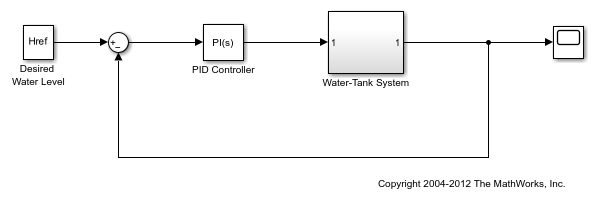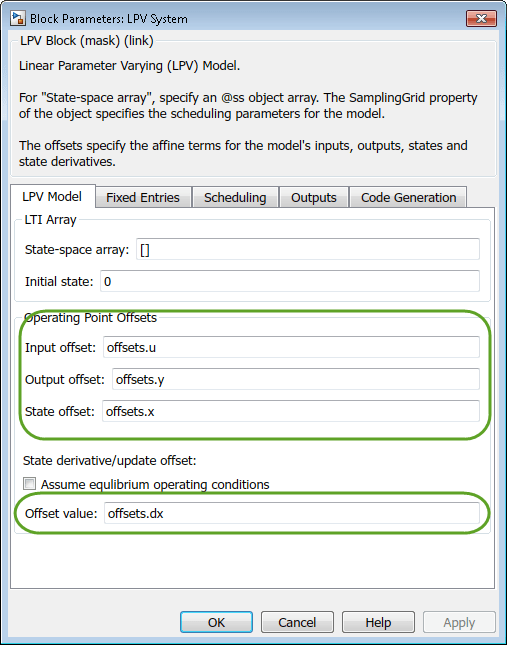getOffsetsForLPV
Extract LPV offsets from linearization results
Description
offsets = getOffsetsForLPV(info)info and converts
them to the array format supported by the LPV
System block.
Examples
Open the Simulink® model.
model = 'watertank';
open_system(model)

Specify linearization I/Os.
io(1) = linio('watertank/Desired Water Level',1,'input'); io(2) = linio('watertank/Water-Tank System',1,'output');
Vary plant parameters A and b, and create a 3-by-4 parameter grid.
[A_grid,b_grid] = ndgrid(linspace(0.9*A,1.1*A,3),linspace(0.9*b,1.1*b,4)); params(1).Name = 'A'; params(1).Value = A_grid; params(2).Name = 'b'; params(2).Value = b_grid;
Create a linearization option set, setting the StoreOffsets option to true.
opt = linearizeOptions('StoreOffsets',true);
Linearize the model using the specified parameter grid, and return the linearization offsets in the info structure.
[sys,op,info] = linearize('watertank',io,params,opt);
Extract the linearization offsets.
offsets = getOffsetsForLPV(info)
offsets =
struct with fields:
x: [2×1×3×4 double]
y: [1×1×3×4 double]
u: [1×1×3×4 double]
dx: [2×1×3×4 double]
To configure an LPV System block, use the fields from offsets directly.

Input Arguments
Linearization information returned by exact linearization commands,
specified as a structure. This structure has an Offsets field
that contains an N1-by-...-by-Nm array
of structures, where N1 to Nm are
the dimensions of the operating point array or parameter grid used
for linearization. Each structure in info.Offsets contains
offset information that corresponds to a specific operating point.
You can store and obtain linearization offsets when you linearize your model using one of the following commands:
For example:
opt = linearizeOptions('StoreOffsets',true);
[sys,op,info] = linearize(mdl,io,params,opt);You can then extract the offset information using getOffsetsForLPV.
offsets = getOffsetsForLPV(info);
Output Arguments
Linearization offsets corresponding to the operating points at which the model was linearized, returned as a structure with the following fields:
| Field | Description |
|---|---|
x | State offsets used for linearization, returned as an nx-by-1-by-N1-by-...-by-Nm array,
where nx is the number of
states in the linearized system. |
y | Output offsets used for linearization, returned as an ny-by-1-by-N1-by-...-by-Nm array,
where ny is the number of
outputs in the linearized system. |
u | Input offsets used for linearization, returned as an nu-by-1-by-N1-by-...-by-Nm array,
where nu is the number of
inputs in the linearized system. |
dx | Derivative offsets for continuous time systems, or updated
state values for discrete-time systems, returned as an nx-by-1-by-N1-by-...-by-Nm array. |
For instance, suppose that your model has three inputs, two
outputs, and four states. If you linearize your model using a 5-by-6
array of operating points, offsets contains arrays
with the following dimensions:
offsets.x— 4-by-1-by-5-by-6offsets.y— 2-by-1-by-5-by-6offsets.u— 3-by-1-by-5-by-6offsets.dx— 4-by-1-by-5-by-6
To configure an LPV System block,
you can use the fields of offsets directly. For
an example, see Approximate Nonlinear Behavior Using Array of LTI Systems.
Version History
Introduced in R2016b
MATLAB Command
You clicked a link that corresponds to this MATLAB command:
Run the command by entering it in the MATLAB Command Window. Web browsers do not support MATLAB commands.
Sélectionner un site web
Choisissez un site web pour accéder au contenu traduit dans votre langue (lorsqu'il est disponible) et voir les événements et les offres locales. D’après votre position, nous vous recommandons de sélectionner la région suivante : .
Vous pouvez également sélectionner un site web dans la liste suivante :
Comment optimiser les performances du site
Pour optimiser les performances du site, sélectionnez la région Chine (en chinois ou en anglais). Les sites de MathWorks pour les autres pays ne sont pas optimisés pour les visites provenant de votre région.
Amériques
- América Latina (Español)
- Canada (English)
- United States (English)
Europe
- Belgium (English)
- Denmark (English)
- Deutschland (Deutsch)
- España (Español)
- Finland (English)
- France (Français)
- Ireland (English)
- Italia (Italiano)
- Luxembourg (English)
- Netherlands (English)
- Norway (English)
- Österreich (Deutsch)
- Portugal (English)
- Sweden (English)
- Switzerland
- United Kingdom (English)